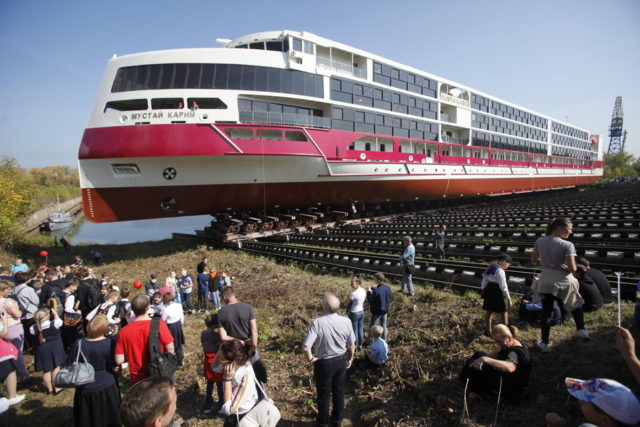
Russia’s Critical River Fleet Not Making the Comeback Moscow Needs
Publication: Eurasia Daily Monitor Volume: 16 Issue: 126
By:

Moscow media last week (September 12) celebrated the launch a new Russian river cruise ship, the Mustay Karim (Vzglyad, September 12). But several weeks earlier, an announcement by Omsk regional officials highlighted just how far down Russia’s once proud river fleet has slipped. Specifically, the authorities of this south-central Russian oblast reached an agreement to allow for grain produced in central Siberia to be shipped northward using foreign vessels, down the Lena River, and then on to Chinese and other Asian markets via the Northern Sea Route (Omskportal.ru, July 29). The central Russian government may be pleased by China’s plans to use the Arctic in this way, but it and the population of Siberia can hardly be expected to be happy that Beijing can now send ships deep into the country’s interior, down a Russian river that the Russian river fleet no longer has the capacity to service.
Given the paucity of roads and railways, Russia has traditionally relied on river communications to tie the country together and to move goods and people about. The Russian Federation has approximately 100,000 kilometers of navigable rivers; but in 2014, it had only a quarter of the riverboats it possessed at the end of Soviet times—9,000, down from 35,400 (Sovershenno Sekretno, May 5, 2016). This number has, if anything, declined further over the last five years, despite periodic upbeat coverage about the launch of new cruise ships—which, it should be noted, are far less significant than cargo-carrying ships and barges.
The situation is now so dire that President Vladimir Putin has been repeatedly peppered with questions about it in recent years during his annual, televised “Direct Line” programs. While the Kremlin has generally ignored this problem in the past, Russia’s National Security Council has begun to take notice because of both the economic and security implications involved. “Of the 15 river basins” in Russia, Anna Astakhova of Sovershenno Sekretno wrote in 2016, “only four (the Amur, the Yenisey, the Volga and the Moskva)” saw traffic increases in any year over the last decade. Most saw radical declines in both raw materials and passengers, with the tonnage carried by the entire system falling to 115 million tons, down from 600 million tons annually in the 1980s and 400 million annually at the end of the 1990s. Some people in the government and the expert community are even beginning to ask whether Russia in fact needs river transport—a question, Astakhova points out, that “would never have entered the head of anyone in Soviet times” (Sovershenno Sekretno, May 5, 2016).
Russia’s river transport system has faced an enormous set of challenges since 1991, she says. Its former transportation partners are now its competitors; banks are unwilling to finance projects with long amortization times; rivers are not being sufficiently dredged; and its stock of cargo vessels is aging and not being replaced, with some of it simply being sold off for the value of the metal it contained (see EDM, February 7, 2019). Unless there is a new state program for the river fleet, the expert suggests, it may simply die out in the coming decades, further restricting Russia’s economic growth and limiting the ability of people, goods and raw materials to move around (Sovershenno Sekretno, May 5, 2016).
This year, the collapse of the Russian river fleet has been compounded by global warming, which has not only sparked massive forest fires throughout Russia east of the Urals but also halted most river traffic because the rivers are not deep enough to handle the remaining ships. As a result, many living in Russia’s High North are not able to receive the supplies they need for the coming winter. Additionally, this limits the development of the eastern half of the Northern Sea Route.
The hardest hit of the Siberian rivers is the Lena: 77 percent of its route crosses the rapidly melting permafrost, and the hardest hit of the regions are the northernmost portions of the Sakha Republic—many of which are beyond any rail or highway and depend on the river. For example, in Yakutsk, the republic’s capital, the water level of the Lena has fallen two and a half meters, leaving many vessels stranded in the mud and killing off the fish on which residents depend. As a result, Russian experts say, villages and towns will have to be supplied by air or risk depopulation (Siberian Times, August 27; Windowoneurasia2.blogspot.com, August 28).
The role of internal waterways in Siberia and the Russian Far East is not as great now as it was at the time that the region was opened by Russian explorers, but it remains far more important than many might expect because there are almost no highways or railroads once one travels 200–300 kilometers north of the Mongolian and Chinese borders. Without a large riverine fleet, almost all of those who moved into the region in Soviet and post-Soviet times will leave, and the remaining population of indigenous peoples will be forced to return to a life of subsistence. If that occurs, and unless something changes soon, a large part of what is shown as Russia on the map will not be Russian at all. Chinese media are already saying that as a result of the declining size of the Russian river fleet and the drying up of that country’s rivers due to climate change, Russia has a smaller “effective territory” than China does (Inosmi.ru, September 13). If that is the case—or even if China simply believes it to be true—the collapse of Russia’s river fleet may soon have far greater consequences than anyone can now imagine.



